written and photographed by Mary L. Peachin
Feb 1997, Vol. 1 No. 5
 For a fleeting moment, the massive school of scalloped hammerheads glided into view. The noise of the bubbles from a scuba diver’s regulator propelled the sharks away from the reefs and into the blue water of the Galapagos Islands of Ecuador.
For a fleeting moment, the massive school of scalloped hammerheads glided into view. The noise of the bubbles from a scuba diver’s regulator propelled the sharks away from the reefs and into the blue water of the Galapagos Islands of Ecuador.
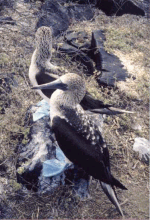 The Galapagos and the Cocos Islands, 300 hundred miles south of Costa Rica, are two major hammerhead dive destinations. Both feature the thrill of being in the water with “big stuff,” sharks, mantas, and an occasional whale. The water temperature in the Galapagos hovers at a chilly 70-degrees, this is definitely wet suit diving.
The Galapagos and the Cocos Islands, 300 hundred miles south of Costa Rica, are two major hammerhead dive destinations. Both feature the thrill of being in the water with “big stuff,” sharks, mantas, and an occasional whale. The water temperature in the Galapagos hovers at a chilly 70-degrees, this is definitely wet suit diving.
The variety and size of the fish combined with fascinating land hiking to view the endemic species of the Galapagos makes this dive destination unique. Our daily schedule on the liveaboard dive boat was almost frenetic. Twelve of us dived and hiked each day, with a bonus dive thrown in one night.
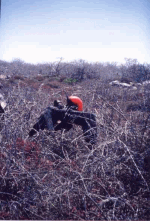 After diving, a zodiac would drop us on the shoreline of an island where we would hike several miles viewing the indigenous species of that island. Then the small rubber boat would retrieve us and take us to the next dive site
After diving, a zodiac would drop us on the shoreline of an island where we would hike several miles viewing the indigenous species of that island. Then the small rubber boat would retrieve us and take us to the next dive site
On our final day our synchronized back roll from the zodiac serendipidously dropped us into a school of rare Golden rays. At our request, boat captain, Julio, gave us a return visit to Gordon’s Rock on North Seymour Island to again view the magnificent frigatebirds.
Piranha Fishing and Bird Watching in the Amazon Basin, Ecuador
A Journey to La Selva Jungle Lodge
The hand carved wooden canoe tipped precariously when the piranha grabbed the chunk of beef hooked to the monofilament handline we borrowed from the native fishermen.
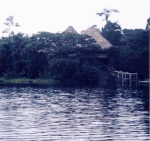 After cautiously retrieving the tugging fish, I passed the line our Napo Quichua guide. Skillfully, Carlos gripped the fish behind the gill and removed the hook. The piranha is known for its reputation of devouring cattle in minutes using its razor sharp teeth.
After cautiously retrieving the tugging fish, I passed the line our Napo Quichua guide. Skillfully, Carlos gripped the fish behind the gill and removed the hook. The piranha is known for its reputation of devouring cattle in minutes using its razor sharp teeth.
During the twilight hours, we had been paddling on Lake Garzacocha (Heron Lake) in eastern Ecuador to observe exotic birds like the hoatzin and greater ani, as well as monkeys, and crocodile-like caiman. We knew about the piranha in the lake and asked if we could give the fishing a try.
The experience of catching a six-inch piranha is not unlike catching a blue gill or perch. But the razor sharp teeth, which snapped as Carlos unhooked the fish in the bow of the canoe, made an exciting difference. We would eat the fairly tasteless fried ribs for dinner that evening. Traveling to La Selva Jungle Lodge, located near the occasionally hostile border of Peru, requires an overnight bus ride from Quito or a flight by military transport plane to the dusty oil booming town of Coca, the last Ecuadorian military post on the Napo River.
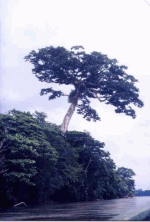 From Coca, a walk through town takes you to a primitive pier on the Napo river, one of the tributaries feeding directly into the Amazon river. The scenic journey begins on the Napo river in a motorized dug out canoe with a thatched-palm roof. As the wooden canoe speeds down the river, the driver swerves to avoid sand bars. Steering the canoe from one side of the river to the other, he avoids being grounded. Three hours later, bottom sore and bladder bursting, the canoe ride ends at a dock edging the rain forest.
From Coca, a walk through town takes you to a primitive pier on the Napo river, one of the tributaries feeding directly into the Amazon river. The scenic journey begins on the Napo river in a motorized dug out canoe with a thatched-palm roof. As the wooden canoe speeds down the river, the driver swerves to avoid sand bars. Steering the canoe from one side of the river to the other, he avoids being grounded. Three hours later, bottom sore and bladder bursting, the canoe ride ends at a dock edging the rain forest.
After a quick “pit-stop” in a thatched roof hut near the dock, we hiked through the rain forest on a handmade walkway. The planks, made from the wood of the chonta palm, were covered with moss and, occasionally, one of the boards was missing or broken.
At the end of the walkway, we climbed into a smaller non-motorized dug out canoe. Two guides, seated in the front and back, paddled us 30-minutes down a jungle-covered stream until we reached and crossed Lake Garzacocha, the beautiful setting of La Selva Jungle Lodge.
The Lodge’s thatched roof open air bar and dining room is rises high above the jungle floor. Yellow-rumped caciques rested in pendulum nests near the railing. Bird watchers come from all over the world to view the more than 400 species of exotic birds in this rain forest.
During our three-day visit we saw a lots of insects, plants, and birds. There were leaf cutting, army, and large, black conga (with a nasty bite) ants, and we had a nightly patrol of red ants in the bathroom of our hut.
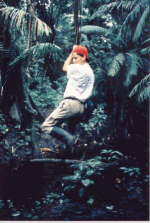 The poisonous bufo and dendrobates toads croaked as we hiked along the trail. There were camouflaged walking sticks, caterpillars with several false heads, tarantulas, white-fronted capuchin and morph butterflies. The owl’s eye butterflies were seen passing through the stages of their life cycle: eggs to pupae to caterpillar to butterfly.
The poisonous bufo and dendrobates toads croaked as we hiked along the trail. There were camouflaged walking sticks, caterpillars with several false heads, tarantulas, white-fronted capuchin and morph butterflies. The owl’s eye butterflies were seen passing through the stages of their life cycle: eggs to pupae to caterpillar to butterfly.
The bird watching was awesome. We saw white-throated toucans, prehistoric looking hoatzin, screaming pihas, yellow- rumped caciques, and the greater kiskadee. There were white-wing swallows, greater egrets, and smooth-billed anis. Anigas, yellow-ridged toucan and yellow- billed nunbirds mixed with many parrots including the mealy, yellow-crown, and blue-headed species. There was the red-bellied macaw, vilocaeous jay, spangled continga, and crested oropendola. And there were more: the rare sand-colored night hawk, common piping guan, osprey, ruddy pigeons, dusty-head parakeets, red-cap cardinals, masked crimson tanagers, rufescent tiger and cocoi herons, ringed kingfishers, the striated ant thrush, and the blacktail trogan. After a day of birdwatching it was easy to understand why visitors traveled from around the world to take the long trip up the Napo river to visit La Selva Jungle Lodge.
Otavalo Market
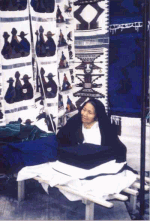 Otavaeno weavers have been using the backstrap loom to weave alpaca sweaters for 4000 years. Each Saturday they hold a local market where visitors can purchase wonderful woven goods at inexpensive prices. The Otavalo market is located an hour and an half north of Quito. The drive, which by taxi costs about $30.00, cuts across the Equator as it passes through the ancient land of the Incas.
Otavaeno weavers have been using the backstrap loom to weave alpaca sweaters for 4000 years. Each Saturday they hold a local market where visitors can purchase wonderful woven goods at inexpensive prices. The Otavalo market is located an hour and an half north of Quito. The drive, which by taxi costs about $30.00, cuts across the Equator as it passes through the ancient land of the Incas.
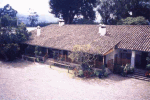 The Cara Indians, predecessors to the Incas, built fifteen pyramids near the small pueblo of Tabacundo, about halfway to Otavalo. A national archaeological site has been created and includes a small museum filled with artifacts. Other villages near Otavalo include Calderon, a place to purchase hand-made folk art decorations, and Cotacachi, a small village known for its leatherwork.
The Cara Indians, predecessors to the Incas, built fifteen pyramids near the small pueblo of Tabacundo, about halfway to Otavalo. A national archaeological site has been created and includes a small museum filled with artifacts. Other villages near Otavalo include Calderon, a place to purchase hand-made folk art decorations, and Cotacachi, a small village known for its leatherwork.
Six miles south of Otavalo is an inn named Hacienda Cusin. Built in 1602, the interior was renovated in 1990. The owner restored the antique tile roof, and kept the cobblestone courtyard, which is entered through a massive wooden gate. Beautiful hand-manicured gardens surround the main building. Corralled in a courtyard are horses saddled and ready for riding. Gourmet meals, formally served, are cooked in a wood-burning oven.
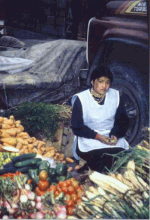 At Saturday market, the Otavalenos arrive in traditional dress about five in the morning to trade and barter for pigs, goats, and cows. Prospective buyers might pried open the mouths of a squealing pig to examine the teeth to determine its value. Cattle were pushed off the back of pick up trucks. A women was seen grappling with a dozen pigs roped together.
At Saturday market, the Otavalenos arrive in traditional dress about five in the morning to trade and barter for pigs, goats, and cows. Prospective buyers might pried open the mouths of a squealing pig to examine the teeth to determine its value. Cattle were pushed off the back of pick up trucks. A women was seen grappling with a dozen pigs roped together.
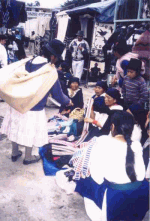 Around seven in the morning, Poncho Plaza comes to life. Blankets, sweaters, hats, scarves, ponchos, and other woolen goods are displayed and sold by the natives using small booths. The market includes vegetables, meats, fish, poultry, household goods, and clothing vendors, each located on a different street.
Around seven in the morning, Poncho Plaza comes to life. Blankets, sweaters, hats, scarves, ponchos, and other woolen goods are displayed and sold by the natives using small booths. The market includes vegetables, meats, fish, poultry, household goods, and clothing vendors, each located on a different street.
A visit to Otavalo and the inn of Hacienda Cusin is a great extension to any trip to Quito. It combines wonderful lodging, the archeological history of the Incas, and a fascinating market.
For further information: email [email protected]
